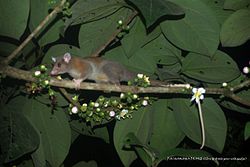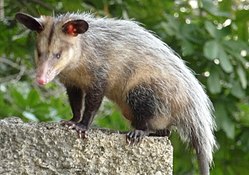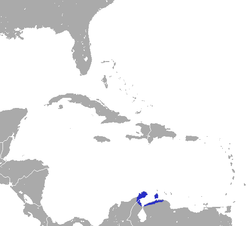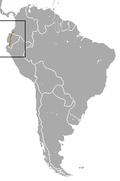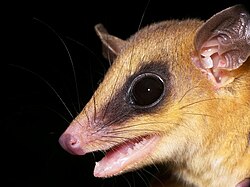| Common name | Scientific name and subspecies | Range | Size and ecology | IUCN status and estimated population |
|---|
| Amazonian red-sided opossum
| M. glirina
(Wagner, 1842) | Central South America
 | Size: 7–20 cm (3–8 in) long, plus 4–11 cm (2–4 in) tail [97]
Habitat: Forest [98]
Diet: Small vertebrates, insects, carrion, seeds, and fruit [97] | LC
Unknown  [98] [98]
|
|---|
| Emilia's short-tailed opossum
| M. emiliae
(Thomas, 1912) | Central South America
 | Size: 7–20 cm (3–8 in) long, plus 4–11 cm (2–4 in) tail [97]
Habitat: Forest [99]
Diet: Small vertebrates, insects, carrion, seeds, and fruit [97] | LC
Unknown  [99] [99]
|
|---|
| Gray short-tailed opossum 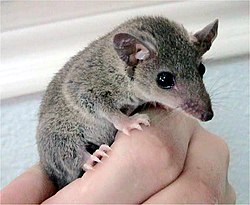 | M. domestica
(Wagner, 1842) | Central and eastern South America
 | Size: 10–15 cm (4–6 in) long, plus tail [100]
Habitat: Forest, shrubland, and grassland [101]
Diet: Insects, fruits, and small animals [100] | LC
Unknown  [101] [101]
|
|---|
| Handley's short-tailed opossum
| M. handleyi
Solari, 2007 | Central South America | Size: 7–20 cm (3–8 in) long, plus 4–11 cm (2–4 in) tail [97]
Habitat: Forest [102]
Diet: Small vertebrates, insects, carrion, seeds, and fruit [97] | DD
Unknown  [102] [102]
|
|---|
| Hooded red-sided opossum
| M. palliolata
(Osgood, 1914) | Northern South America
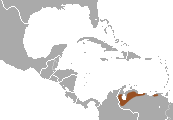 | Size: 7–20 cm (3–8 in) long, plus 4–11 cm (2–4 in) tail [97]
Habitat: Forest [103]
Diet: Small vertebrates, insects, carrion, seeds, and fruit [97] | LC
Unknown  [103] [103]
|
|---|
| Ihering's three-striped opossum
| M. iheringi
(Thomas, 1888) | Eastern South America
 | Size: 7–20 cm (3–8 in) long, plus 4–11 cm (2–4 in) tail [97]
Habitat: Forest and unknown [104]
Diet: Small vertebrates, insects, carrion, seeds, and fruit [97] | DD
Unknown  [104] [104]
|
|---|
| Long-nosed short-tailed opossum  | M. scalops
(Thomas, 1888) | Eastern South America
 | Size: 7–20 cm (3–8 in) long, plus 4–11 cm (2–4 in) tail [97]
Habitat: Forest [105]
Diet: Small vertebrates, insects, carrion, seeds, and fruit [97] | LC
Unknown  [105] [105]
|
|---|
| Northern red-sided opossum  | M. brevicaudata
(Erxleben, 1777) | Northern South America
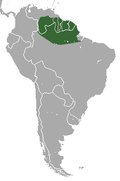 | Size: 7–20 cm (3–8 in) long, plus 4–11 cm (2–4 in) tail [97]
Habitat: Forest [106]
Diet: Small vertebrates, insects, carrion, seeds, and fruit [97] | LC
Unknown  [106] [106]
|
|---|
| Northern three-striped opossum  | M. americana
(Müller, 1776) | Eastern South America
 | Size: 7–20 cm (3–8 in) long, plus 4–11 cm (2–4 in) tail [97]
Habitat: Forest and shrubland [107]
Diet: Small vertebrates, insects, carrion, seeds, and fruit [97] | LC
Unknown  [107] [107]
|
|---|
| One-striped opossum
| M. unistriata
(Wagner, 1842) | Southeastern South America
 | Size: 7–20 cm (3–8 in) long, plus 4–11 cm (2–4 in) tail [97]
Habitat: Forest [108]
Diet: Small vertebrates, insects, carrion, seeds, and fruit [97] | CR
2–10  [108] [108]
|
|---|
| Osgood's short-tailed opossum
| M. osgoodi
Doutt, 1938 | Western South America
 | Size: 7–20 cm (3–8 in) long, plus 4–11 cm (2–4 in) tail [97]
Habitat: Forest [109]
Diet: Small vertebrates, insects, carrion, seeds, and fruit [97] | LC
Unknown  [109] [109]
|
|---|
| Peruvian short-tailed opossum
| M. peruviana
(Osgood, 1913) | Peru | Size: 7–20 cm (3–8 in) long, plus 4–11 cm (2–4 in) tail [97]
Habitat: Forest [110]
Diet: Small vertebrates, insects, carrion, seeds, and fruit [97] | LC
Unknown  [110] [110]
|
|---|
| Pygmy short-tailed opossum
| M. kunsi
Pine, 1975 | Central South America
 | Size: 7–20 cm (3–8 in) long, plus 4–11 cm (2–4 in) tail [97]
Habitat: Forest and savanna [111]
Diet: Small vertebrates, insects, carrion, seeds, and fruit [97] | LC
Unknown  [111] [111]
|
|---|
| Reig's opossum
| M. reigi
Lew, Pérez-Hernández, 2004 | Northern South America
 | Size: 7–20 cm (3–8 in) long, plus 4–11 cm (2–4 in) tail [97]
Habitat: Forest [112]
Diet: Small vertebrates, insects, carrion, seeds, and fruit [97] | VU
Unknown  [112] [112]
|
|---|
| Ronald's opossum
| M. ronaldi
Solari, 2004 | Western South America
 | Size: 7–20 cm (3–8 in) long, plus 4–11 cm (2–4 in) tail [97]
Habitat: Forest [113]
Diet: Small vertebrates, insects, carrion, seeds, and fruit [97] | LC
Unknown  [113] [113]
|
|---|
| Sepia short-tailed opossum
| M. adusta
(Thomas, 1897) | Northwestern South America
 | Size: 9–13 cm (4–5 in) long, plus 4–7 cm (2–3 in) tail [114]
Habitat: Forest [115]
Diet: Invertebrates, fruits and small vertebrates [114] | LC
Unknown  [115] [115]
|
|---|
| Yellow-sided opossum  | M. dimidiata
(Wagner, 1847) | Southern South America
 | Size: 7–20 cm (3–8 in) long, plus 4–11 cm (2–4 in) tail [97]
Habitat: Forest, grassland, and inland wetlands [116]
Diet: Small vertebrates, insects, carrion, seeds, and fruit [97] | LC
Unknown  [116] [116]
|
|---|



